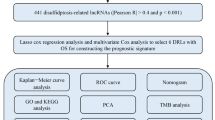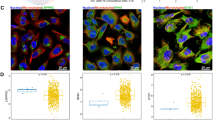Abstract
Disulfidptosis is a newly discovered form of regulatory cell death. However, the identification of disulfidptosis-related molecular subtypes and potential biomarkers in gliomas and their prognostic predictive potential need to be further elucidated. RNA sequencing profiles and the relevant clinical data were obtained from the Cancer Genome Atlas (TCGA) and the Chinese Glioma Genome Atlas (CGGA). Disulfidptosis-related clusters were identified by unsupervised clustering analysis. Immune cell infiltration analysis and drug sensitivity analysis were used to explore the differences between clusters. Gene set enrichment analysis (GSEA) of differential genes between clusters was performed to explore the potential biological functions and signaling. A disulfidptosis-related scoring system (DRSS) was constructed based on a combined COX and LASSO analysis. Mendelian randomization (MR) analyses were used to further explore the causal relationship between levels of genes in DRSS and an increased risk of glioma. A prognosis nomogram was constructed based on the DRSS and 3 clinical features (age, WHO stage, and IDH status). The accuracy and stability of the prognosis nomogram were also validated in different cohorts. We identified two clusters that exhibited different prognoses, drug sensitivity profiles, and tumor microenvironment infiltration profiles. The overall survival (OS) of Cluster2 was significantly better than Cluster1. Cluster1 had an overall greater infiltration of immune cells compared to Cluster2. However, the Monocytes, activated B cells had higher infiltration abundance in Cluster2. GSEA results showed significant enrichment of immune-related biological processes in Cluster1, while Cluster2 was more enriched for functions related to neurotransmission and regulation. PER3, RAB34, NKX3-2, GPX7, FRA10AC1, and TGIF1 were finally included to construct DRSS. DRSS was independently related to prognosis. There was a significant difference in overall survival between the low-risk score group and the high-risk score group. Among six genes in DRSS, GPX7 levels were demonstrated to have a causal relationship with an increased risk of glioma. GPX7 may become a more promising biomarker for gliomas. The prognosis nomogram constructed based on the DRSS and three clinical features has considerable potential for predicting the prognosis of patients with glioma. Free online software for implementing this nomogram was established: https://yekun-zhuang.shinyapps.io/DynNomapp/. Our study established a novel glioma classification based on the disulfidptosis-related molecular subtypes. We constructed the DRSS and the prognosis nomogram to accurately stratify the prognosis of glioma patients. GPX7 was identified as a more promising biomarker for glioma. We provide important insights into the treatment and prognosis of gliomas.










Similar content being viewed by others
Data Availability
Publicly available datasets were analyzed in this study. This data can be found here: https://xenabrowser.net/datapages/ and http://www.cgga.org.cn/; further inquiries can be directed to the corresponding authors.
References
Azzaoui I et al (2016) T-cell defect in diffuse large B-cell lymphomas involves expansion of myeloid-derived suppressor cells. Blood 128(8):1081–1092. https://doi.org/10.1182/blood-2015-08-662783
Bagley SJ et al (2018) CAR T-cell therapy for glioblastoma: recent clinical advances and future challenges. Neuro Oncol 20(11):1429–1438. https://doi.org/10.1093/neuonc/noy032
Bi G et al (2020) A nomogram with enhanced function facilitated by nomogramEx and nomogramFormula. Ann Transl Med 8(4):78–78. https://doi.org/10.21037/atm.2020.01.71
Blanche P, Dartigues J, Jacqmin‐Gadda H (2013) Estimating and comparing time‐dependent areas under receiver operating characteristic curves for censored event times with competing risks. Stat Med 32(30):5381–5397. https://doi.org/10.1002/sim.5958
Bush NAO, Chang SM, Berger MS (2017) Current and future strategies for treatment of glioma. Neurosurg Rev 40(1):1–14. https://doi.org/10.1007/s10143-016-0709-8
Chen H et al (2023) Leveraging a disulfidptosis-based signature to improve the survival and drug sensitivity of bladder cancer patients. Front Immunol. https://doi.org/10.3389/fimmu.2023.1198878
Cheng YQ et al (2020) Modifying the tumour microenvironment and reverting tumour cells: new strategies for treating malignant tumours. Cell Prolif 53(8):e12865. https://doi.org/10.1111/cpr.12865
Emdin CA, Khera AV, Kathiresan S (2017) Mendelian randomization. JAMA. 318(19):1925–1926. https://doi.org/10.1001/jama.2017.17219
Engebretsen S, Bohlin J (2019) Statistical predictions with glmnet. Clin Epigenetics 11(1):123. https://doi.org/10.1186/s13148-019-0730-1
Feng PH et al (2012) CD14 S100A9 monocytic myeloid-derived suppressor cells and their clinical relevance in non–small cell lung cancer. Am J Respir Crit Care Med 186(10):1025–1036. https://doi.org/10.1164/rccm.201204-0636OC
Finotello F et al (2019) Molecular and pharmacological modulators of the tumor immune contexture revealed by deconvolution of RNA-seq data. Genome Med 11(1):34. https://doi.org/10.1186/s13073-019-0638-6
Fu T et al (2021) Spatial architecture of the immune microenvironment orchestrates tumor immunity and therapeutic response. J Hematol Oncol 14(1):98. https://doi.org/10.1186/s13045-021-01103-4
Gajewski TF, Schreiber H, Fu YX (2013) Innate and adaptive immune cells in the tumor microenvironment. Nat Immunol 14(10):1014–1022. https://doi.org/10.1038/ni.2703
Galon J, Bruni D (2019) Approaches to treat immune hot, altered and cold tumours with combination immunotherapies. Nat Rev Drug Discov 18(3):197–218. https://doi.org/10.1038/s41573-018-0007-y
Goldenberg NM, Grinstein S, Silverman M (2007) Golgi-bound Rab34 is a novel member of the secretory pathway. Mol Biol Cell 18(12):4762–4771. https://doi.org/10.1091/mbc.e06-11-0991
Goldman MJ et al (2020) Visualizing and interpreting cancer genomics data via the Xena platform. Nat Biotechnol 38(6):675–678. https://doi.org/10.1038/s41587-020-0546-8
Guan X et al (2021) CTLA4-mediated immunosuppression in glioblastoma is associated with the infiltration of macrophages in the tumor microenvironment. J Inflamm Res 14:7315–7329. https://doi.org/10.2147/JIR.S341981
Hänzelmann S, Castelo R, Guinney J (2013) GSVA: gene set variation analysis for microarray and RNA-Seq data. BMC Bioinformatics 14(1):7. https://doi.org/10.1186/1471-2105-14-7
Hou P et al (2022) Overexpression of RAB34 associates with tumor aggressiveness and immune infiltration in glioma. Biosci Rep 42(10):BSR20212624. https://doi.org/10.1042/BSR20212624
Huang Y et al (2016) Development and validation of a radiomics nomogram for preoperative prediction of lymph node metastasis in colorectal cancer. J Clin Oncol 34(18):2157–2164. https://doi.org/10.1200/JCO.2015.65.9128
Iclozan C et al (2013) Therapeutic regulation of myeloid-derived suppressor cells and immune response to cancer vaccine in patients with extensive stage small cell lung cancer. Cancer Immunol Immun 62(5):909–918. https://doi.org/10.1007/s00262-013-1396-8
Jalali A et al (2019) Visualising statistical models using dynamic nomograms. PLOS ONE Edited by R. Calabrese 14(11):e0225253.
Jansen H, Samani NJ, Schunkert H (2014) Mendelian randomization studies in coronary artery disease. Eur Heart J 35(29):1917–1924. https://doi.org/10.1093/eurheartj/ehu208
Jia K et al (2020) XTP8 stimulates migration and invasion of gastric carcinoma through interacting with TGIF1. Eur Rev Med Pharmacol Sci 24(5):2412–2420. https://doi.org/10.26355/eurrev_202003_20508
Le S et al (1998) Telomerase activity in human gliomas. Neurosurg 42(5):1120–1124. https://doi.org/10.1097/00006123-199805000-00099. (discussion 1124–1125)
Li Y et al (2023) ‘Identification of disulfidptosis-related subtypes, characterization of tumor microenvironment infiltration, and development of a prognosis model in colorectal cancer. J Cancer Res Clin Oncol [Preprint]. https://doi.org/10.1007/s00432-023-05211-1
Liu X et al (2023) Actin cytoskeleton vulnerability to disulfide stress mediates disulfidptosis. Nat Cell Biol 25(3):404–414. https://doi.org/10.1038/s41556-023-01091-2
Louis DN et al (2021) The 2021 WHO classification of tumors of the central nervous system a summary. Neuro-Oncology 23(8):1231–1251. https://doi.org/10.1093/neuonc/noab106
Love MI, Huber W, Anders S (2014) ‘Moderated estimation of fold change and dispersion for RNA-seq data with DESeq2. Genome Biol 15(12):550. https://doi.org/10.1186/s13059-014-0550-8
Luan F et al (2019) An autophagy-related long non-coding RNA signature for glioma. FEBS Open Bio 9(4):653–667. https://doi.org/10.1002/2211-5463.12601
Maeser D, Gruener RF, Huang RS (2021) oncoPredict: an R package for predicting in vivo or cancer patient drug response and biomarkers from cell line screening data. Brief Bioinform 22(6):bbab260. https://doi.org/10.1093/bib/bbab260
Meyer C et al (2014) Frequencies of circulating MDSC correlate with clinical outcome of melanoma patients treated with ipilimumab. Cancer Immunol Immunother 63(3):247–257. https://doi.org/10.1007/s00262-013-1508-5
Newman AM (2015) Robust enumeration of cell subsets from tissue expression profiles. Nat Methods 12(5):453–457. https://doi.org/10.1038/nmeth.3337
Runa F et al (2017) Tumor microenvironment heterogeneity: challenges and opportunities. Curr mol biol rep 3(4):218–229. https://doi.org/10.1007/s40610-017-0073-7
Thorsson V et al (2018) The immune landscape of cancer. Immunity 48(4):812-830.e14. https://doi.org/10.1016/j.immuni.2018.03.023
Tong X et al (2022) Targeting cell death pathways for cancer therapy: recent developments in necroptosis, pyroptosis, ferroptosis, and cuproptosis research. J Hematol Oncol 15(1):174. https://doi.org/10.1186/s13045-022-01392-3
Van Calster B et al (2018) Reporting and interpreting decision curve analysis: a guide for investigators. Eur Urol 74(6):796–804. https://doi.org/10.1016/j.eururo.2018.08.038
Veglia F, Sanseviero E, Gabrilovich DI (2021) Myeloid-derived suppressor cells in the era of increasing myeloid cell diversity. Nat Rev Immunol 21(8):485–498. https://doi.org/10.1038/s41577-020-00490-y
Vickers AJ et al (2008) Extensions to decision curve analysis, a novel method for evaluating diagnostic tests, prediction models and molecular markers. BMC Med Inform Decis Mak 8(1):53. https://doi.org/10.1186/1472-6947-8-53
Wang B et al (2022) TGIF1 overexpression promotes glioma progression and worsens patient prognosis. Cancer Med 11(24):5113–5128. https://doi.org/10.1002/cam4.4822
Wang Q et al (2023a) Circadian gene Per3 promotes astroblastoma progression through the P53/BCL2/BAX signalling pathway. Gene 895 147978. https://doi.org/10.1016/j.gene.2023.147978
Wang T et al (2023b) Disulfidptosis classification of hepatocellular carcinoma reveals correlation with clinical prognosis and immune profile. Int Immunopharmacol 120 110368. https://doi.org/10.1016/j.intimp.2023.110368
Wang Y et al (2023c) Identification of disulfidptosis-related subgroups and prognostic signatures in lung adenocarcinoma using machine learning and experimental validation. Front Immunol 14:1233260. https://doi.org/10.3389/fimmu.2023.1233260
Wilkerson MD, Hayes DN (2010) ConsensusClusterPlus: a class discovery tool with confidence assessments and item tracking. Bioinformatics 26(12):1572–1573. https://doi.org/10.1093/bioinformatics/btq170
Ye X et al (2012) Tumor-associated microglia/macrophages enhance the invasion of glioma stem-like cells via TGF-β1 signaling pathway. J Immun 189(1):444–453. https://doi.org/10.4049/jimmunol.1103248
Yoshihara K et al (2013) Inferring tumour purity and stromal and immune cell admixture from expression data. Nature Communications 4(1):2612. https://doi.org/10.1038/ncomms3612
Yu G et al (2012) clusterProfiler: an R package for comparing biological themes among gene clusters. OMICSA Journal of Integrative Biology 16(5):284–287. https://doi.org/10.1089/omi.2011.0118
Zeng D et al (2021) IOBR: multi-omics immuno-oncology biological research to decode tumor microenvironment and signatures. Front Immunol 12. Accessed 19 Oct 2023
Zheng P et al (2023) Disulfidptosis: a new target for metabolic cancer therapy. J Exp Clin Cancer Res 42(1):103. https://doi.org/10.1186/s13046-023-02675-4
Zhong J et al (2022) A prognostic pyroptosis-related LncRNA classifier associated with the immune landscape and therapy efficacy in glioma. Front Genet 13:1026192. https://doi.org/10.3389/fgene.2022.1026192
Zhou Y et al (2021) GPX7 is targeted by miR-29b and GPX7 knockdown enhances ferroptosis induced by erastin in glioma. Frontiers in Oncol 11 802124. https://doi.org/10.3389/fonc.2021.802124
Zhu H et al (2021) TUBA1C is a prognostic marker in low-grade glioma and correlates with immune cell infiltration in the tumor microenvironment. Front Genet 12 759953. https://doi.org/10.3389/fgene.2021.759953
Author information
Authors and Affiliations
Contributions
All authors contributed to the study conception and design. Material preparation, data collection, and analysis were performed by Yekun Zhuang, Jiewen Chen, Wanting Huang, Zhuohao Mai, and Wenyu Zhong. The first draft of the manuscript was written by Yekun Zhuang and all authors commented on previous versions of the manuscript. All authors read and approved the final manuscript.
Corresponding author
Ethics declarations
Ethics Approval
Institutional review board approval was not required for publicly available information.
Competing Interests
The authors declare that the research was conducted in the absence of any commercial or financial relationships that could be construed as a potential conflict of interest.
Additional information
Publisher's Note
Springer Nature remains neutral with regard to jurisdictional claims in published maps and institutional affiliations.
Supplementary Information
Below is the link to the electronic supplementary material.
Rights and permissions
Springer Nature or its licensor (e.g. a society or other partner) holds exclusive rights to this article under a publishing agreement with the author(s) or other rightsholder(s); author self-archiving of the accepted manuscript version of this article is solely governed by the terms of such publishing agreement and applicable law.
About this article
Cite this article
Zhuang, Y., Chen, J., Mai, Z. et al. Signature Construction and Disulfidptosis-Related Molecular Cluster Identification for Better Prediction of Prognosis in Glioma. J Mol Neurosci 74, 38 (2024). https://doi.org/10.1007/s12031-024-02216-4
Received:
Accepted:
Published:
DOI: https://doi.org/10.1007/s12031-024-02216-4




